19 September 2014
Pulling secrets from deep-sea, drillbit-eating rocks
Posted by Nanci Bompey
By Amy West
Amy West is the science writer and outreach and education officer for the JOIDES Resolution, a drill ship operated by the International Ocean Discovery Program (IODP) that is on a two-month expedition studying the Izu-Bonin-Mariana Arc in the region where the Pacific Plate is descending under the Philippine Plate to form the Mariana Trench and the deepest point in the ocean–the Challenger Deep. Read more about the expedition here.
When trying to keep up with conversations that throw around words like ‘hyaloclastites’, ‘orthopyroxenes’, or ‘slickensides’ it feels as if I’ve tripped and tumbled into a language course without a study guide. Though definitions may be at my fingertips, tracking them down can quickly turn into a ‘Deeper Definition Dilemma’. I call it my 3D world.
To elucidate: my outreach partner described her track when delving into the meaning of boninite– a significant rock we have collected hundreds of feet beneath the seafloor. Its definition is an andesite high in magnesium. Andesite is thus defined as an extrusive in between a basalt and rhyolite. My previous blog described basalt, yet rhyolite is the volcanic equivalent of granite. Granite’s definition says it’s felsic intrusive of igneous rock.
Wait. So what the heck is boninite again?
And more importantly, why do geoscientists care about it?
When I introduced this expedition, I explained how rocks make this world go round. So, here we go:

Deep-sea rocks that form from the first stages of subduction. Subduction makes the world go ’round.
Credit: Amy West
Most rock names come from the regions where they were first discovered: gabbros in Gabbro, Italy; harzburgite from the Harz mountains in Germany; and andesite from the Andes. Boninite is no different; it’s named after the Bonin Islands just a few miles southwest of us. When George Bush returned to those islands 50 years after being shot down over Chichi-jima in WWII, he likely had no idea he walked on some very special rocks.
Boninite is a rare rock that appears to signal the beginning stages of subduction in an arc island region. So when boninites show up on land, as they do in mountain belts like the Appalachians and Himalayas, it’s a clue that two tectonic plates probably collided there at some point in history.
Where boninites form nowadays is known in only one region- underwater exploding volcanoes a kilometer deep near Tonga. A submersible captured footage back in 2009 of this spectacular show spewing bits of boninite. Our team of scientists surmised this modern day spectacle is similar to what happened 50 million years ago where we’re drilling now.
Scientists believe boninites take a special set of circumstances to form the rock. The recipe calls for water and extremely hot mantle that has previously melted, and essentially melts again at shallower depths at temperatures around 1300-1400°C (~2370-2550°F). Though counterintuitive, this happens because water trapped on the sinking ocean plate infuses into hot mantle rocks on the overriding plate, thus lowering the mantle’s melting point, much like adding salt water to ice to lower the ice’s melting temperature.
Why does this magma from the melted mantle rise up? It fills a “gap” that occurs at the junction between two oceanic plates when they collide and one bends down. This twice-melted mantle already robbed of many elements, bubbles up into the space. Its distinctive chemical signature is reflected in boninitic rock—rich in silica and magnesium and low in titanium unlike other ocean rocks. Water transforms the mineral makeup in the magma by breaking chemical bonds. Boninites don’t appear where new seafloor originates because water is not in the recipe there- it’s just melted mantle.
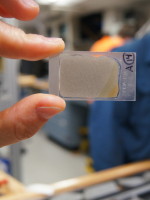
This thin section of rock allows geoscientists to look at the shapes of individual minerals. Credit: Amy West
Finding boninites here in the forearc helps confirm that very hot parts of the mantle were indeed shallow. Though this expedition would like to know why one plate subducted in the first place, this research may offer stronger evidence that supports certain theories- (e.g. the plate sank due to its length and density, or the entire Western Pacific subducted all at once). What the expedition can determine, however, is what happens after the tectonic area fails.
I can’t introduce boninites without spotlighting the layers of rocks lying beneath them. This ‘family’ of rocks also tells historic tales of subduction, and this team wants to drill a complete column of them in the ocean, though these rocks can be seen on land in several places where they are uplifted when continental plates collide (scientists like to toss around the term, “tectonically transported”.) On land, this chunk of ocean floor, known as an ophiolite*, has shifted, twisted, and weathered away over time. If we can pinpoint how these rock layers occur on the seafloor, it can help scientists understand what happened historically on land. Ophiolites occur worldwide, for instance in Oman, Cyprus, California, Chile, and provide a great source of the metals we use in fabrication, such as copper, zinc, gold, and chromium.
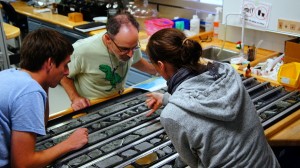
Geochemist Maria Kirchenbaur points out features of the boninites to co-chief scientist, Mark Reagan, and petrologist Tim Chapman.
Credit: Amy West
The debate stems from how ophiolites form and what they represent. Common wisdom was that ophiolites represent all ocean floor, explains Eric Ferré, a structural geologist on this expedition. He argues that drilling into ophiolites on land doesn’t provide a fundamental understanding of the oceanic activities that placed them there.
Expedition 352 could show that ophiolites are not representative of all ocean floor ever formed; they may just be confined to the beginning stages of subduction. The world’s leading experts on ophiolites and boninites are on board this ship, and from the holes we’ve drilled thus far, they are still not entirely sure whether the rock layers lie in layers on top of each other as suspected, or lay like a tilted stack of books along the seafloor. To baffle researchers further, many ophiolites have been found with boninites, indicating a particular subduction process happened many times throughout the world.
Confirming this sequence of rocks may advance our knowledge on how subduction leads to continental crust. But drilling through an entire column of deep seafloor rocks is easier said than done. We are on our 4th hole now, though only had two planned. We’ve brought up unexpected rocks, which can lead to more theories. Some of the rocks at the bottom have nearly trapped us, broken our bit, or refused to provide us any samples.
It may be they are not ready to divulge their secrets just yet.
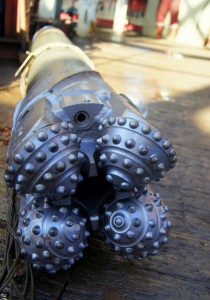
A ‘healthy’ drillbit: the rotary cone barrel (RCB) used for drilling into hard rock.
Credit: Amy West
* Ophiolites sequence that scientists generally agree on: volcanic rocks formed underwater. Then dikes, which are the pipes that feed the magma. Then gabbros, which are the frozen remains of a magma chamber, and below that is the top bit of mantle called peridodites.
– Guest blogger Amy West is the science writer and outreach and education officer for the JOIDES Resolution. This post first appeared on National Geographic’s Ocean Views blog, where you can also read additional blog posts about the expedition. Follow the expedition on Twitter.


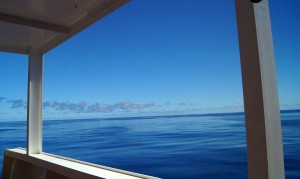
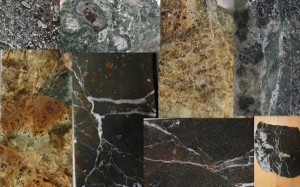
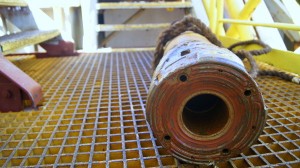
 GeoSpace is a blog on Earth and space science, managed by AGU’s Public Information staff. The blog features posts by AGU writers and guest contributors on all sorts of relevant science topics, but with a focus on new research and geo and space sciences-related stories that are currently in the news.
GeoSpace is a blog on Earth and space science, managed by AGU’s Public Information staff. The blog features posts by AGU writers and guest contributors on all sorts of relevant science topics, but with a focus on new research and geo and space sciences-related stories that are currently in the news.